Scandals of Classic Hollywood: Cary Grant’s Intimate Bromance
by Anne Helen Petersen
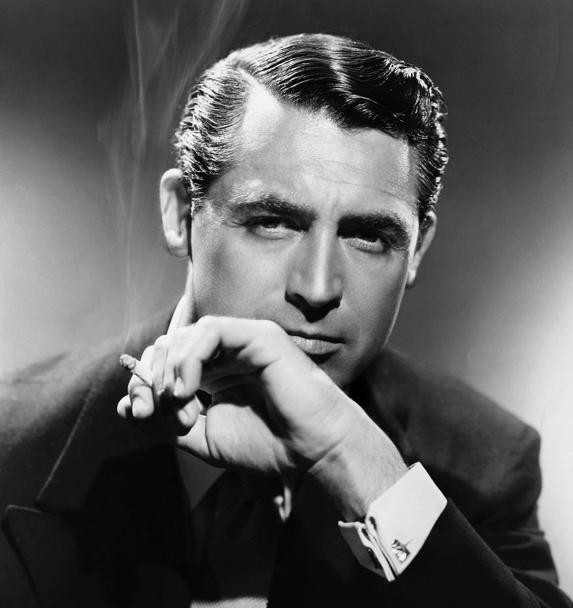
Here is the simple truth about Cary Grant: he was the best and most important actor of the last hundred years. He didn’t reinvent acting like Brando, he didn’t fatten himself up like Robert De Niro or starve himself like Christian Bale. He wasn’t burly like Gable, and he didn’t smolder like Mitchum. Instead, he played slight variations on the same character for the majority of his career, he wore a suit better than anyone in Hollywood, and he made acting seem like living. Over the course of his long career, Grant fixed standards of what it meant to be “debonair” and “a man about town” — everything he did, on screen and off, seemed inflected with panache and grace. Or, as my professor from undergrad used to sum him up: “The man knew how to wear clothes.” Indeed he fucking did.
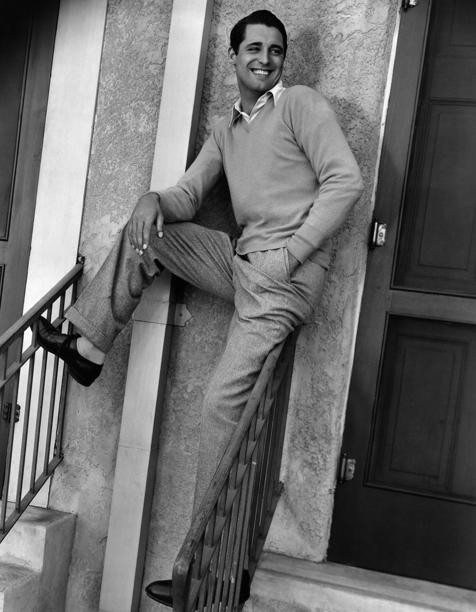
But the phrase “knew how to wear clothes” is a loaded one. To “know how to wear clothes” is another way of saying that Grant embodied class, which is to say high class: Grant wore well-tailored clothes, and he knew how to hold himself in them. But he came from nothing, and the way he wore clothes was just as much of a performance as his refined trans-Atlantic accent, his acrobatic slapstick routines, and his masterful flirtation skills. When a tailor returned a collar point even an eighth of an inch too short, he sent it back. He understood that only through attention to seemingly meaningless details could a quasi-orphaned vaudevillian become one of the most enduring and beloved stars of the 20th century.
Rumors of Grant’s bisexuality swirled around Hollywood for years: was he a man-about-town who liked to have sex with men-about-town? But as evidenced by the story of Rock Hudson, Hollywood was adept at covering queerness with a varnish of hyper-heterosexuality, and women fell at his feet both onscreen and off. As will become clear, it was and remains unclear whether Grant actually was bisexual or whether he simply reveled in messing with anxieties sparked by two men living together. It seems unlikely that Grant, a practiced comedian, would not have been amused by befuddling as many gossip columnists as possible.
But all that came later. Grant, born Archibald Alexander Leach, spent the early years of his life in an unhappy home in Bristol, England. At age nine, Leach’s father put his mother in a mental institution. He soon remarried, abandoning young Archie to the care of the state. Leach was expelled from school at 14 and joined a traveling stage troupe, quickly mastering the art of stilt-walking. In 1920, at all of 16, Leach and the troupe left Britain for a two-year American tour, from which he would never return. He joined the American vaudeville circuit, spending a significant chunk of time on the St. Louis stage and refining the acrobatic, juggling, and miming skills that would serve him for the rest of his entertainment career. You might laugh, but the sort of immaculate movement control required of a vaudevillian is the same sort of control necessary for intricate flirtation. This is why football players are such bad flirts and ballet dancers and unicyclists, however weird, are such good ones.
After a stint on Broadway, Archie Leach moved to Hollywood, signed a contract with Paramount, and changed his name to Cary Grant. From the beginning, he was cast as wealthy and sophisticated, playing very young, very rich, and very boring opposite Marlene Dietrich in Blonde Venus in 1932. Then Mae West (who deserves about five posts of her own — I mean REALLY, this lady was happening) selected Grant to play her love interest in back-to-back films — She Done Him Wrong and I’m No Angel. The latter was a monster hit, but West was the main attraction; Grant was just window-dressing. Yet this window-dressing nevertheless attracted women, including his first wife, Virginia Cherrill, whom he met at the premiere for Blonde Venus. The relationship had the reek of a studio-arranged affair, especially when the two divorced a year later amid rumors that Grant had become depressed and disillusioned with his ready-made romance.
Grant was pretty to look at, but seemed to lack charisma. So Paramount let him loose, freeing him to sign as an independent with Columbia and RKO, which cast him in a smattering of comedic roles, including Sylvia Scarlett (1935) opposite a cross-dressing Katharine Hepburn.
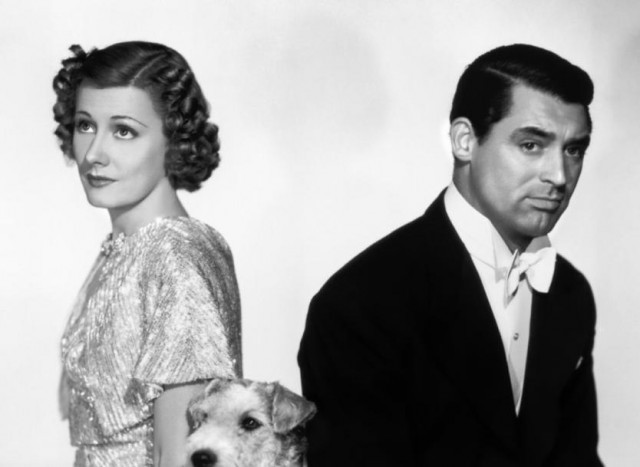
Grant’s comedic potential was clear, and Columbia paired him with Irene Dunne in The Awful Truth. I’ve seen nearly every classic screwball, but none bring down the house quite as effectively as The Awful Truth. Like so many screwballs of the ’30s, it centers on what Stanley Cavell terms a “comedy of remarriage”: the film starts with a divorce, then spends the remainder bringing the couple back together. (Sweet Home Alabama = 21st century comedy of remarriage.) In The Awful Truth, Irene Dunne has left Grant for a new, very Oklahoman suitor. Two summers ago I saw it in Austin, and the crowd was basically rolling in the aisles, because the only thing that Texans like more than BBQ are jokes at Oklahoma’s expense.
There’s a brilliant moment when Grant, out to dinner with Dunne and her Oklahoma suitor, watches as the two take the dance floor. Oklahoma boy starts with some fancy dance moves that clearly embarrass Dunne. She has no choice but to keep up, and super awkwardness ensues. But the camera keeps cutting back to Grant, casually sitting at the table — he watches the couple with slight disgust, but then, as the dancing gets more and more ridiculous, his disgust turns to glee. (Start at 4:00 for maximum ridiculousness.)
https://www.youtube.com/watch?v=ww72BH6Mifg
That moment when he stands up and takes an even closer seat, crossing his legs and folding his hands — it’s the finishing cherry on the sundae of a scene.
This brand of casually potent humor, purportedly based on the tastes of The Awful Truth’s director, Leo McCarey, would structure Grant’s image from that point forward.
And so began what is arguably the best series of films by any actor EVER:
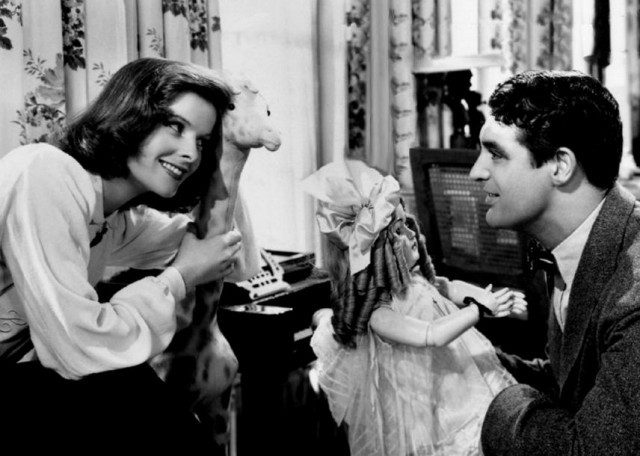
All sorts of ridiculous and romantic in Holiday with Katharine Hepburn (1938);
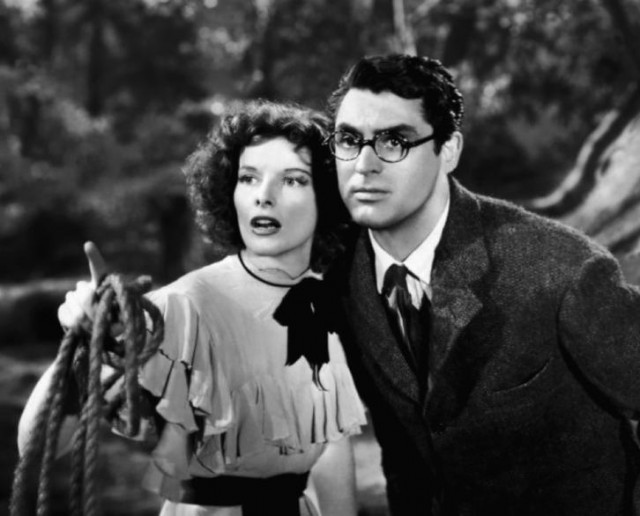
Playing a huge dork, complete with spectacles, in Bringing Up Baby (1939);
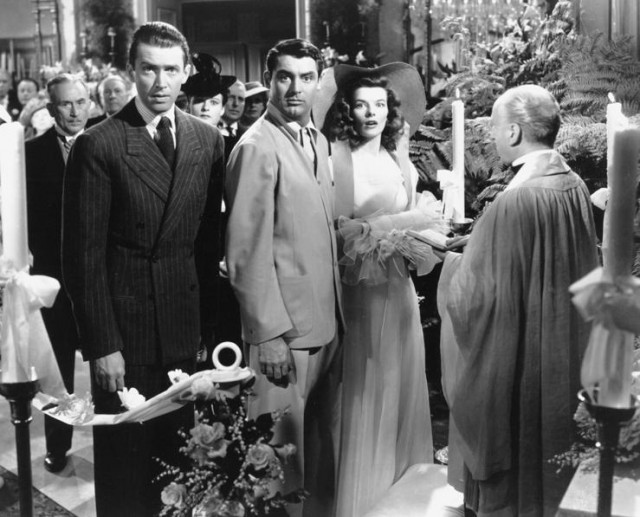
Taking the role of the relative straight man in The Philadelphia Story (1940) with Hepburn again, only add the super-bonus of Jimmy Stewart at his most drunk and amusing;
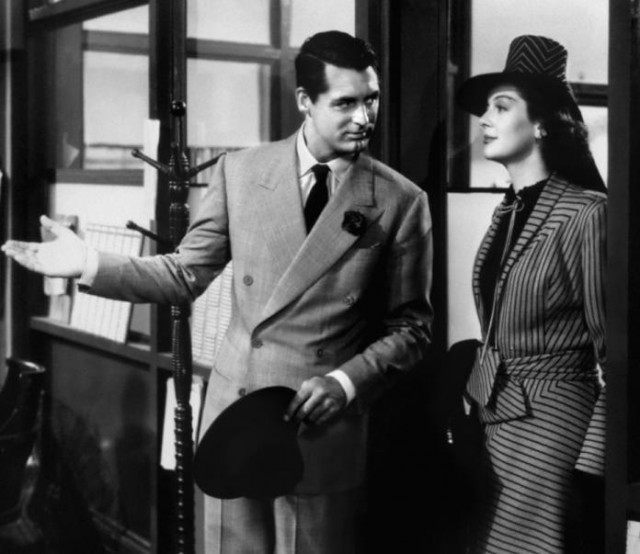
And, perhaps most hilarious of all, talking 500 words a minute in His Girl Friday with Rosalind Russell (1940).
You guys, I could talk about each of these films FOR HOURS. I could write a thousand words on each and just be getting started. I could write a thousand words just on the way that Katharine Hepburn holds her chin, or the magnificence that is Russell’s wardrobe in His Girl Friday. But what really matters is that each of these films is a masterpiece, and I could watch them forever and never want for more.
Part of their greatness stems from the writing. Part of it stems from the inherent speed and intensity of the screwball. Part of it stems from the fact that Grant’s characters were not attracted to beauty, per se, but to beauty paired with wit and intelligence. But most of it is Grant himself. Don’t mistake me: I love — love! — Hepburn, Dunne, and Russell, even though the Russell was a bit of a wet blanket away from Grant. But Grant provided the alchemy that made all four of these films into classics: without him, they’re just genre pics.
During this first period of success, Grant had been living, on and off, with an actor named Randolph Scott. Grant and Scott had met on the set of Hot Saturday, where both men played suitors to the same leading lady. The two hit it off immediately and shared an apartment until Grant’s first marriage in 1934. After Grant’s divorce, it was 24-hour bro-time, and the two rented a sprawling seven-bedroom Santa Monica beach house, widely known as the “Bachelor Hall.”
Here’s where it becomes unclear whether Grant was just making fun of nosy gossip columnists or actually bisexual. The two had women over all the time — but hey, George Clooney also has many, many (vetted) girlfriends, and Tom Cruise has been married three times. Gossip columnists warned that the couple had “taken things too far”: while other stars posed for fan mag spreads with their wives, Grant and Scott reveled in homosocial domestic bliss.
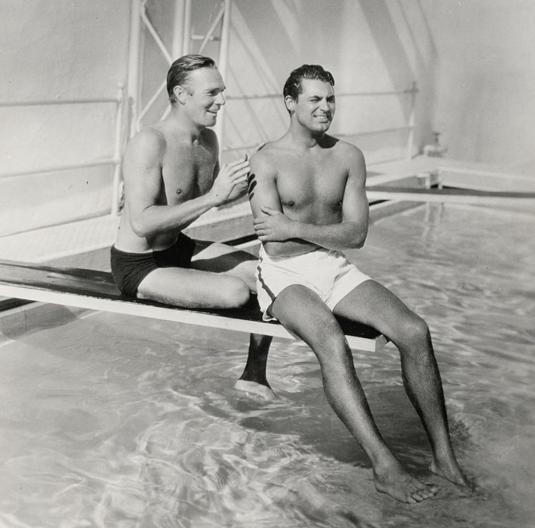
Chillaxing on the diving board!
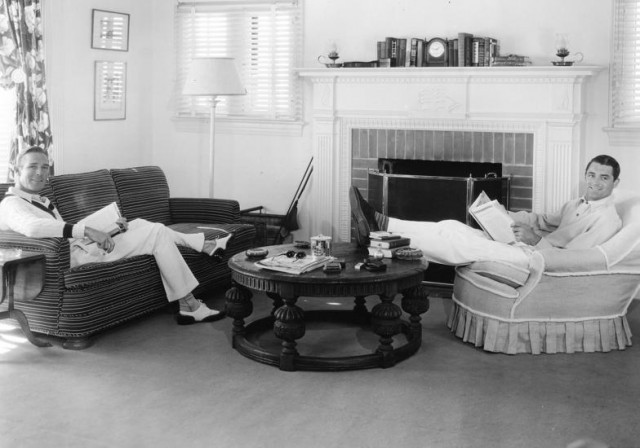
Doing a little light reading!
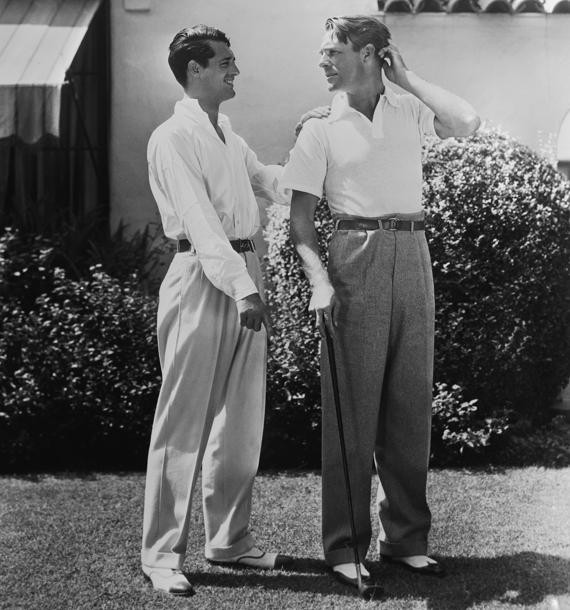
Playing floppy-trouser golf!
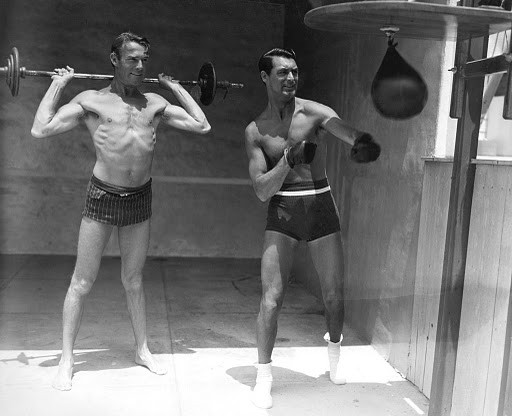
Sculpting and jazzercising!
Scott even signed a menu from a dinner party with “To my spouse, Cary.”
So here are our options:
1. Grant and Scott were gay and used the lady-parties as a cover. They joked about being gay so as to deflect real anxiety about them being gay.
2. Grant and Scott were not gay, and found the anxiety over close male friendship amusing, playing it up for the press.
3. We’ll never know whether they were gay or not, but Grant’s all the more interesting because of the ambiguity, not to mention the presence of high-waisted boxing shorts. Those calves!
I vote for option number three.
In 1940, the two co-starred in My Favorite Wife, playing rival suitors to Irene Dunne. Dunne and Grant had already proven their chemistry, and Wife made it clear that Scott and Grant had it as well. But take it as you will: if you want to read sublimated gay desire into the film, that reading is available; if you don’t, that’s fine too. I support both!
Grant received his first Oscar nomination in 1941 for his performance in the over-the-top melodrama Penny Serenade. And let it be said: this film is ridiculous. There are more flashbacks than Memento. There are laughably faux Japanese sets, countless adoptions and baby deaths, and we are asked to believe that Grant really, really cares about being a good father. I mean, even the way Grant is crossing his legs is ridiculous.
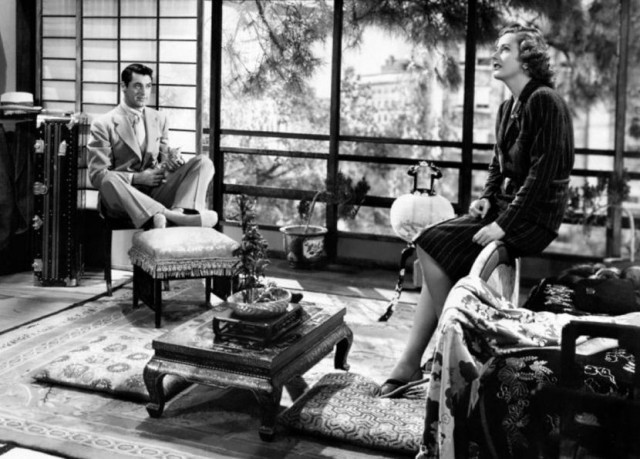
Grant’s image encompassed many characteristics, but dedicated fatherhood (at least at this moment) was not one of them. But as remains true today, the Academy loves to honor a sad-sack maudlin performance over a pitch-perfect comedic one, which is why Kristen Wiig will probably get the shaft until she adopts a black child and teaches him how to play football.
In 1941 Grant also appeared in Suspicion, the first of many collaborations with Alfred Hitchcock. (Hitchcock: “Grant is the only actor I ever truly loved!”) Suspicion is generally pushed aside in the Hitchcock pantheon, but it does feature Grant at his darkest and most menacing, which leads me to block it out of my cinematic memory the same way that I block Jimmy Stewart’s Vertigo creepface.
In Suspicion, Grant naturally plays a handsome, charismatic rogue who seduces an innocent young woman (naturally Joan Fontaine, best known for not-being-Rebecca in Rebecca) and sweeps said woman her off her feet, despite her family’s objections. After the two marry, it becomes super f-ing clear that the rogue is totally broke and married Fontaine’s character for her money. He gambles! He embezzles! His best friend mysteriously dies while they’re away in Europe! He makes queries concerning untraceable poisons!!!
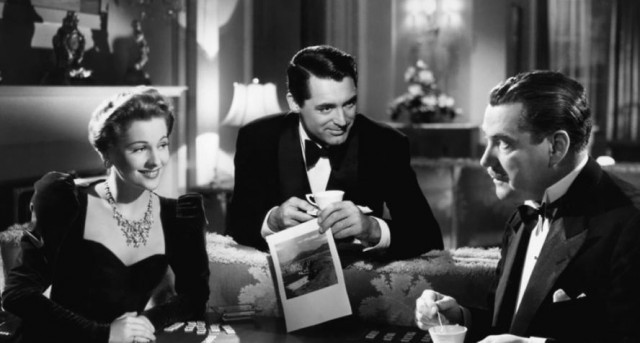
Looking very devious during a high stakes Scrabble game
AHHHHHH SHIT, Grant is totally trying to kill Fontaine for the insurance money! Of course, this being Hitchcock, there’s something far more psychologically screwed up going on, and Grant does not, in fact, want to kill his wife. But the film marked the first of many times that Hitchcock would play with moviegoers’ expectations for a Cary Grant character, highlighting the ways in which smooth exteriors distract from generalized nefariousness.
The film’s plot also mirrored Grant’s extra-textual life — mere months after the movie’s release, Grant began a whirlwind romance with Barbara Hutton, Woolrich heiress, most eligible bachelorette, and, due to her tragic upbringing and marital turmoil, best known as “America’s Poor Little Rich Girl.” Hutton had already plowed through a Prince and a Baron, it was only natural that she’d be paired with the most dashing man on the big screen. Grant signed a detailed pre-nuptial agreement, but the golddigger rumors stuck — OH, I DON’T KNOW WHY, MAYBE BECAUSE HE STARRED IN THAT MOVIE WHERE HE MARRIED THE GIRL FOR MONEY?? — and the two were dubbed “Cash and Cary.”
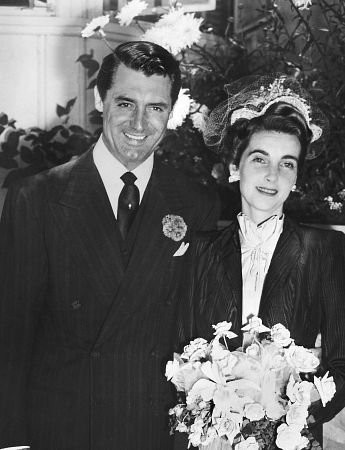
Like all studio-contracted stars during the golden age, Grant continued to make two to three films a year. Between 1942 and 1949, he appeared in nineteen films — highlights include the Hitchcock-directed Notorious (Ingrid Bergman is a nerdy doctor!) and I Was a Male War Bride, which highlighted Grant’s capacity for masquerade. He and Hutton divorced in 1945, and in 1949, he and an actress named Betsy Drake met cute on a cross-Atlantic voyage on the Queen Mary.
And boy was this Betsy a character. Her grandfather had founded Chicago’s very chi-chi Drake Hotel, but the family had lost the farm, as it were, in the stock market crash. She had grown up a drama queen, switching schools TWELVE TIMES the way that only truly insufferable people (or army brats) do. When an agent convinced her to sign a studio contract, she got herself out of it by having herself declared insane. She fled L.A. to New York, auditioned for an Elia Kazan play, and went to go perform it in London.
As the story goes, Grant saw her in this play, and they just happened to be on the same ship back stateside. He “begged” (seriously? can you imagine Cary Grant begging for anything?) his friend and fellow Hollywood star Merle Oberon for an introduction, and things went forward from there. After lots of canoodling and above-board making out, Grant convinced RKO Studios to sign her to another contract. (I don’t understand why RKO thought this was a good idea; hello, previous insanity strategy.) Drake appeared with Grant in Every Girl Should Get Married (1948) and WHAT DO YOU KNOW the two stars got married. In a private ceremony. On Christmas Day. With Howard Hughes as the best man.
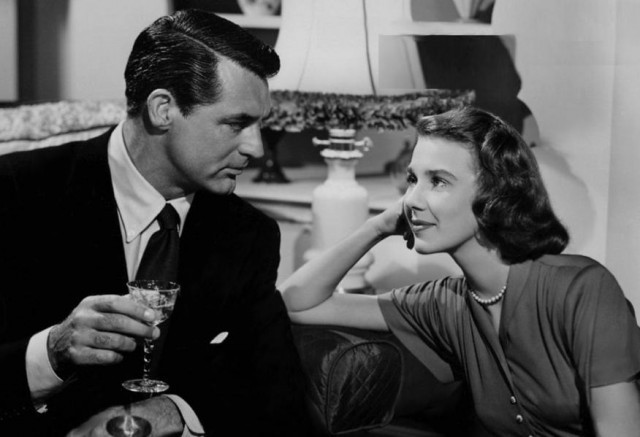
Grant and Drake looking rather mismatched in Every Girl Should Get Married.
This smells fishy to me. But it stuck for nearly 12 years — well, okay, it was totally over in 1954, when Grant started working with Sophia Loren and fell head-over-heels, as people generally did when it came to Loren. But Grant, like many others in Hollywood, started receiving then-totally-legal LSD therapy during the disintegration of the marriage. At the time, one simply went to go receive treatment — which usually lasted 8–12 hours — at an office, and afterwards, when you were all loopy and jonesing for some tie-dye, you were picked up by a friend at the end. Kinda like after dental surgery, only less drooling.
After trying LSD, Grant became its most visible advocate: he loved it, and he especially loved how it helped him with his inner demons. For a man who had worked so diligently to cultivate his suave, put-together image, this was a huge deal. And he didn’t just mention it to a friend — he told Look Magazine (People : Us Weekly as Life : Look) that he took LSD because “I wanted to rid myself of all my hypocrises. I wanted to work through the events of my childhood, my relationship with my parents and my former wives. I did not want to spend years in analysis.”
Exchange “wives” for “unfortunate make-out sessions” and ME TOO, CARY, MEEE TOO.
Good Housekeeping, which is essentially the most boring magazine in America, even valorized Grant’s groundbreaking experimentation with the drug, pointing to how Grant had “courageously permit[ted] himself to be one of the subjects of a psychiatric experiment with a drug that eventually may become an important tool in psychotherapy.” In other words, millions of housewives were told that getting high was AWESOME.
During this LSD-infused period, Grant seemed to get more and more tan. In reality, he was just appearing in movies that were in color. But he did seem quite golden (accentuated by the use of ‘50s-era coloring processes, which I could give you a 75-minute lecture on [I have totally given this 75-minute lecture] regarding why it made faces look the way they did, and why it made it easier for white people to play brown people and thus allow Hollywood to continue its nasty, unstated boycott of actual brown people). The most important of these films, however, were all made for Hitchcock.
To Catch a Thief! I mean, I realize this film is a confection. I realize that anytime I mention it in a discussion of Hitchcock I’ll get a giant guffaw. BUT YOU GUYS, there is so much going on this film, like Grace Kelly at her coldest and most (arguably) beautiful, Cary Grant in shorty shorts on the Mediterranean centuries before Daniel Craig in shorty shorts on the Mediterranean, and a distinct sense of Hitchcock making fun of all parties involved. And Grant as a catbugler/confidence man is brilliant: who better to play a man who plays at acting rich in order to finagle women’s jewels than a poor boy who’s played at being rich all of his adult life?
https://www.youtube.com/watch?v=Le-X36HfBGI
When you watch this clip, two things become clear:
1. It’s not hard to see where the rumors of Kelly’s voracious sexual appetite originated.
2. Hitchcock loves juxtaposing sexual tension with explosions. Fireworks! In case you’re not picking up what Hitch is putting down: THAT MEANS ORGASM, even if you couldn’t see it onscreen.
Over the course of his career, Grant did a lot of firm embracing and what I like to call “fish kissing” — the mouth opens, the couple moves in, the lips touch, and then they just sit there, gills opening and closing for the allotted period of time. “Fish kissing” developed because the Hays Code forbade tongue kissing, but as a result, gilling around and smooshing faces with Grace Kelly was the closest Grant ever got to a veritable love scene. Which, if you think about it, is really saying something: the sexiest man of Classic Hollywood didn’t need to do full frontal. He didn’t even need to take off his shirt. He just crossed his legs and raised his eyebrows. WOWZA.
With Grant well into his ’40s, the films just kept coming: An Affair to Remember, which is basically a Nicholas Sparks film, and North by Northwest, a willfully confusing masterpiece, with Hitchcock again using our expectations of Grant’s star image to psychologically and narratively fuck us over. But NxNW also gave us one of the most enduring images of cinema, with Grant, all suit and polish, stranded in the middle of a field and sprinting for his life.
As writer Todd McEwen declared, “North by Northwest isn’t a film about what happens to Cary Grant, it’s about what happens to his suit” — a suit GQ called the best in film history. Having seen so much classic Hollywood cinema, that is saying something, and that something is spectacular.
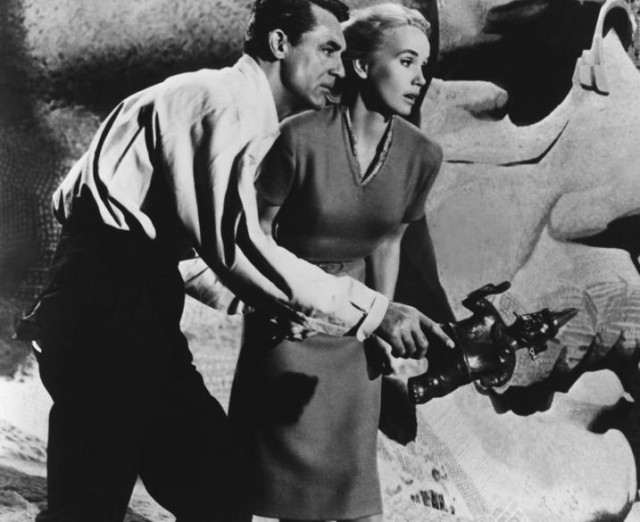
All over Hollywood in the ’50s, quality films were in decline. Ironically, actors, especially ones with high asking prices like Grant, were making fewer and fewer films, but the ones they did make were given such large budgets that they had to succeed, leading to all sorts of over-production. Too many spoons in the stew; too many chefs in the kitchen; too few profits to go around. Grant was good, but this was a different calculus, and my guess is he was probably pretty exhausted by playing himself. By the time we get to Charade (1962), it’s not that he’s too old for Audrey Hepburn as much as he lacked the stamina to match Hepburn’s incessant doe-eyeing. Grant’s brand of obstinate flirtation, always toe-to-toe with the likes of Hepburn the Elder, here seems more like crotchety grandparenting.
But unlike most Hollywood stars, Grant never underwent a true (or public) decline. He kept up appearances, married a really, really young Dyan Cannon (33 years his junior) and, in 1966, fathered his first child.
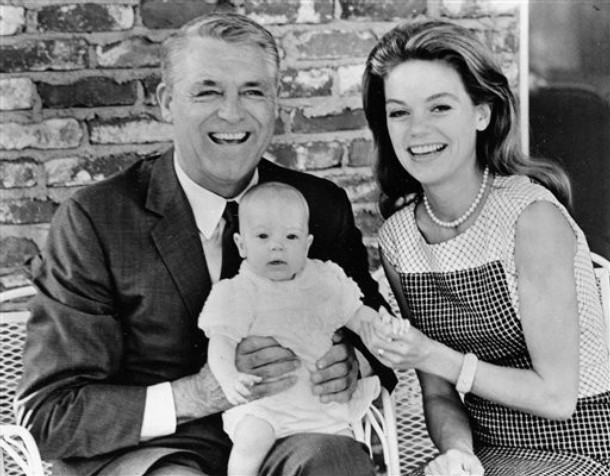
With the birth of his daughter, Grant retired from the screen to dedicate himself to fatherhood. In 1970, he at last received an Oscar for “his unique mastery of the art of screen acting with the respect and affection of his colleagues.” In other words: Grant received an Oscar for being so much more awesome than everyone else still alive in Hollywood. He spent the last years of his life reveling in his own silver foxness and doing ridiculous things like serving on the board of Fabergé. Grant divorced Canon relatively quickly, married again, and, after living a full and glorious life, passed away at the age of 82 in 1986, with more than 70 films to his name.
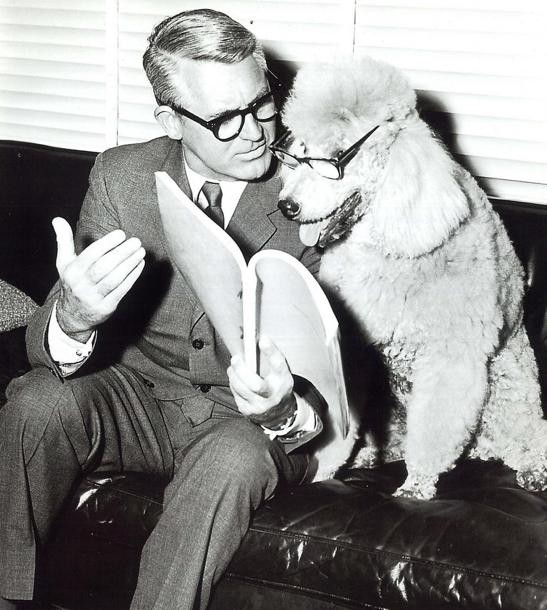
When someone says another person is “Cary Grant-esque,” you know exactly the way that man holds himself, exactly the cut of his suit, exactly the way he appraises a situation and the people within it. You know his power over women, his impeccable social timing, and his ability to master the ebb and flow of conversation to his advantage. To be Grant-esque is to be the immaculate socialite, sartorially refined, and the object of affection and admiration. And such clarity of image, and the exacting self-discipline it took to maintain it, must have been exhausting. As Grant himself famously remarked, “Everyone wants to be Cary Grant — even I want to be Cary Grant.”
Which returns us back to the question of Grant’s relationships with men. Grant admitted that his first two wives suspected he was gay, but Betsy Drake shot down such rumors, asking “Why would I believe that Cary was a homosexual when we were busy fucking?” TOUCHE, BETS.
But I’m going to suggest something radical: we’ll never know whether Grant was or was not gay, and it does not matter. What matters was that his image, for all its perfection, also had its points of flexibility — living intimately with a man for long stretches of time, doing cute man things together — that leaves the possibility open. Grant made millions of women swoon, and millions of straight men aspire to his likeness. But he also provided thousands of queer audience members with the hope that famous, successful, high-profile performers and homosexuality were not mutually exclusive, further suggesting straight, high-class masculinity as an elaborate masquerade.
Grant’s image was in many ways univocal — he played variations of the same character, he seemed to be a ladies’ man on and off the screen — but it also had room for a voice of dissent, one that made alternative interpretations possible and plausible. And this, in the end, is why Cary Grant mattered and continues to matter: he could mean so many exquisite, beautiful things to so many different people.
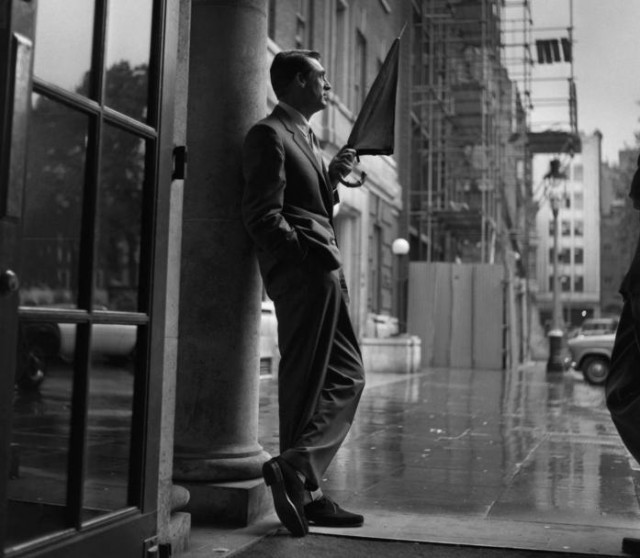
Previously: Rita Hayworth, Tragic Princess.Anne Helen Petersen is a Doctor of Celebrity Gossip. No, really. You can find evidence (and other writings) here.